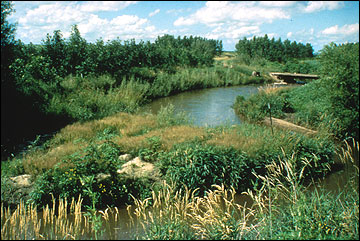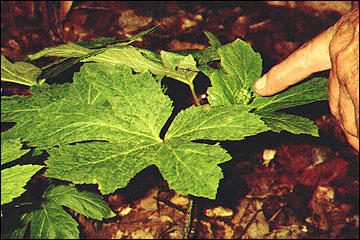Editor's note
The following abstract describes a publication that is only available as a downloadable PDF.
Agroforestry is a set of integrated land use practices combining trees, shrubs, forages, grasses, livestock and crops in innovative, flexible combinations tailored to the landowner's needs. The goal in agroforestry is to optimize production and conservation benefits.
In the temperate United States, agroforestry consists of five main practices:
- Alley cropping
- Silvopasture
- Riparian forest buffers
- Windbreaks
- Forest farming.
When designing and implementing any of the five practices, it is important to consider the compatibility of the species with the site, the compatibility between species, the farm equipment available and the potential markets.
 Harvesting wheat between walnut trees in an alley cropping practice.
Harvesting wheat between walnut trees in an alley cropping practice.
Alley cropping
Alley cropping is the planting of trees and/or shrubs in single or multiple tree rows at relatively wide spacing with a companion crop grown in the alleyways between the tree rows. The benefits realized in alley cropping practices include increased income diversity, biological diversity, improved aesthetics and reduced negative environmental impacts. Alley cropping practices are designed according to the site characteristics, the tree products desired (e.g., nuts or timber), the growth requirements of the selected tree, the crop being grown in the alleyway, the farm equipment available and the landowner's objectives.
Silvopasture
Silvopasture deliberately combines trees with forage and livestock production in an intensively managed practice. Letting cows graze in a natural woodland area without any type of tree or forage management is NOT considered a silvopastoral practice.
Several benefits are realized by implementing a silvopasture practice. Trees protect livestock from temperature extremes by blocking cold wind and snow in winter and providing shade in summer. Livestock benefit from improved forage quality and reduce the need for chemical or mechanical vegetation control. Research at the University of Missouri Center for Agroforestry has shown that many forages, such as red clover and smooth bromegrass, perform better, are more palatable, and produce higher levels of desired nutrients under some shade.
 Tree roots stabilize stream banks and herbaceous vegetation grows in naturally.
Tree roots stabilize stream banks and herbaceous vegetation grows in naturally.
Riparian forest buffers
Riparian forest buffers can have positive impacts on water quality. They are strips of planted or managed trees, shrubs and grasses along the banks of waterways. One popular design consists of three zones: Zone 1, undisturbed forest, is closest to the water; Zone 2, managed forest, is next to the undisturbed forest; and Zone 3, composed of grasses,is farthest from the water.
Zone 2, the managed forest, can be planted with fast growing trees and/or shrubs that produce marketable products which can be harvested for profit.
Windbreaks
Windbreaks protect crops and livestock from strong winds, reduce wind erosion,
improve irrigation efficiency, expand wildlife habitat, improve aesthetics, manage snow and provide marketable products. Protection from cold wind and snow and hot, drying summer winds improves crop quality and yield despite the loss of cropping area due to the windbreak. Windbreaks provide shade and protection from temperature extremes in pastures and around feedlots improving livestock health, feeding efficiency and reproductive success. Increased plant and wildlife diversity have the potential to reduce fertilizer and pesticide inputs by capitalizing on natural pest predators and nutrient cycling.
 Fruiting goldenseal in a forest farming practice.
Fruiting goldenseal in a forest farming practice.
Forest farming
Forest farming is a unique practice in which existing forest stands are managed to create an appropriate environment for growing potentially high value understory crops. Many medicinal and botanical plants that are currently wild-crafted (harvested from wild sources) from public and private lands are becoming scarce. Forest farming can mitigate over- harvesting by managing for these scarce, high value species.
Topics
- Increase crop production
- Diversify products and farm income
- Improve soil quality and reduce erosion
- Improve water quality and reduce damage due to flooding
- Enhance wildlife habitat and improve biodiversity
- Reduce pest management inputs
Pages
- 12